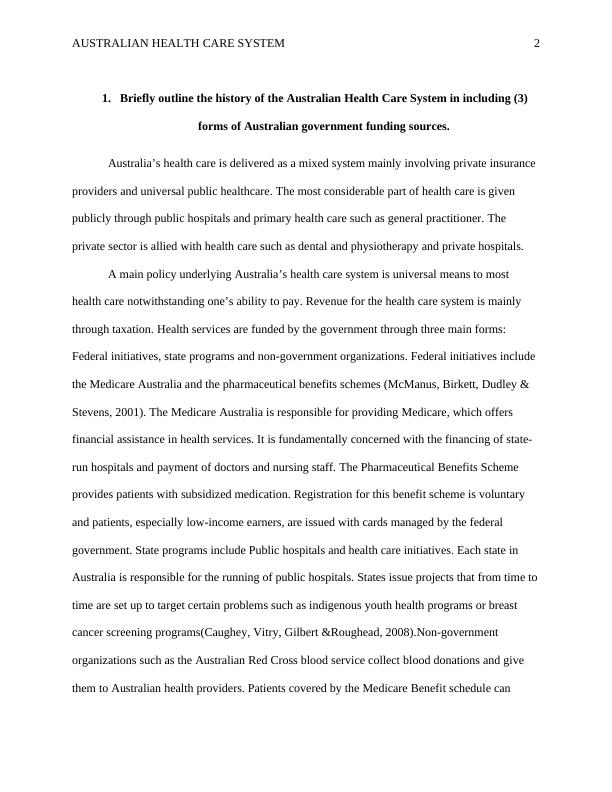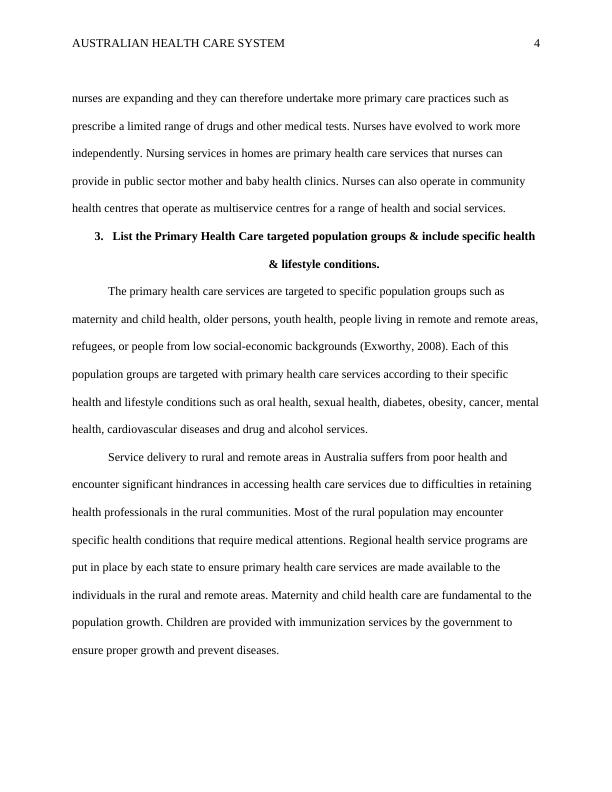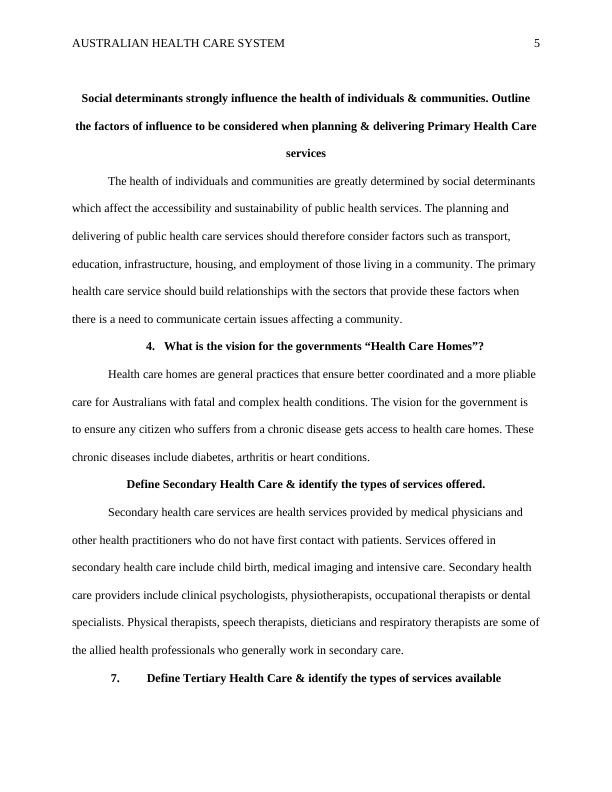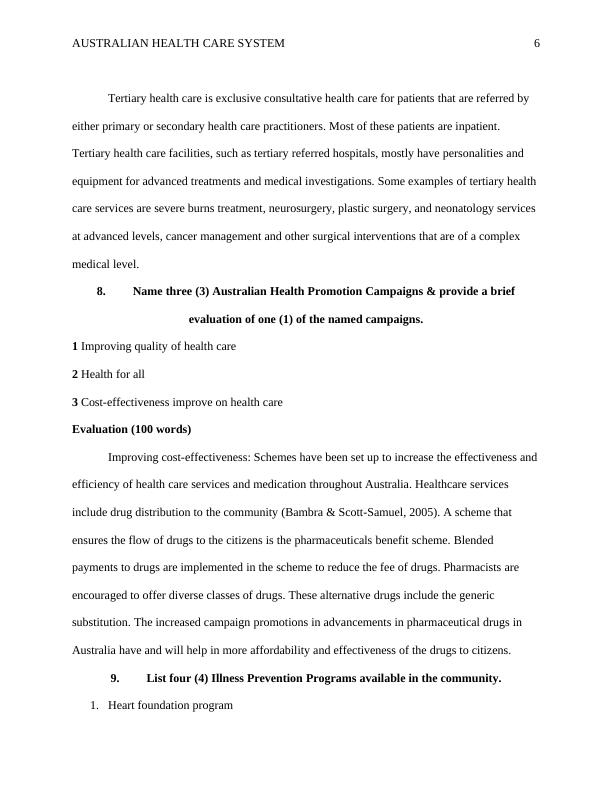Nursing within the Australian Health Care System
The assignment is a workbook assignment for the course HLTENN001 Practise Nursing within the Australian Health Care System.
25 Pages6432 Words44 Views
Added on 2023-02-01
About This Document
This document provides an overview of nursing within the Australian Health Care System. It covers the history of the system, funding sources, primary health care, targeted population groups, and more. The document also discusses the vision for the government's 'Health Care Homes' and provides information on secondary and tertiary health care. Additionally, it lists Australian health promotion campaigns, illness prevention programs, and provides details on the funding of the public and private sectors. The document concludes with information on Medicare and its purpose, coverage, and safety nets.
Nursing within the Australian Health Care System
The assignment is a workbook assignment for the course HLTENN001 Practise Nursing within the Australian Health Care System.
Added on 2023-02-01
ShareRelated Documents
Running head: AUSTRALIAN HEALTH SYSTEM
1
Nursing within the Australian Health Care System
Student’s Name
Institution Affiliation
1
Nursing within the Australian Health Care System
Student’s Name
Institution Affiliation

AUSTRALIAN HEALTH CARE SYSTEM 2
1. Briefly outline the history of the Australian Health Care System in including (3)
forms of Australian government funding sources.
Australia’s health care is delivered as a mixed system mainly involving private insurance
providers and universal public healthcare. The most considerable part of health care is given
publicly through public hospitals and primary health care such as general practitioner. The
private sector is allied with health care such as dental and physiotherapy and private hospitals.
A main policy underlying Australia’s health care system is universal means to most
health care notwithstanding one’s ability to pay. Revenue for the health care system is mainly
through taxation. Health services are funded by the government through three main forms:
Federal initiatives, state programs and non-government organizations. Federal initiatives include
the Medicare Australia and the pharmaceutical benefits schemes (McManus, Birkett, Dudley &
Stevens, 2001). The Medicare Australia is responsible for providing Medicare, which offers
financial assistance in health services. It is fundamentally concerned with the financing of state-
run hospitals and payment of doctors and nursing staff. The Pharmaceutical Benefits Scheme
provides patients with subsidized medication. Registration for this benefit scheme is voluntary
and patients, especially low-income earners, are issued with cards managed by the federal
government. State programs include Public hospitals and health care initiatives. Each state in
Australia is responsible for the running of public hospitals. States issue projects that from time to
time are set up to target certain problems such as indigenous youth health programs or breast
cancer screening programs(Caughey, Vitry, Gilbert &Roughead, 2008).Non-government
organizations such as the Australian Red Cross blood service collect blood donations and give
them to Australian health providers. Patients covered by the Medicare Benefit schedule can
1. Briefly outline the history of the Australian Health Care System in including (3)
forms of Australian government funding sources.
Australia’s health care is delivered as a mixed system mainly involving private insurance
providers and universal public healthcare. The most considerable part of health care is given
publicly through public hospitals and primary health care such as general practitioner. The
private sector is allied with health care such as dental and physiotherapy and private hospitals.
A main policy underlying Australia’s health care system is universal means to most
health care notwithstanding one’s ability to pay. Revenue for the health care system is mainly
through taxation. Health services are funded by the government through three main forms:
Federal initiatives, state programs and non-government organizations. Federal initiatives include
the Medicare Australia and the pharmaceutical benefits schemes (McManus, Birkett, Dudley &
Stevens, 2001). The Medicare Australia is responsible for providing Medicare, which offers
financial assistance in health services. It is fundamentally concerned with the financing of state-
run hospitals and payment of doctors and nursing staff. The Pharmaceutical Benefits Scheme
provides patients with subsidized medication. Registration for this benefit scheme is voluntary
and patients, especially low-income earners, are issued with cards managed by the federal
government. State programs include Public hospitals and health care initiatives. Each state in
Australia is responsible for the running of public hospitals. States issue projects that from time to
time are set up to target certain problems such as indigenous youth health programs or breast
cancer screening programs(Caughey, Vitry, Gilbert &Roughead, 2008).Non-government
organizations such as the Australian Red Cross blood service collect blood donations and give
them to Australian health providers. Patients covered by the Medicare Benefit schedule can

AUSTRALIAN HEALTH CARE SYSTEM 3
claim services such as medical imaging and other health services from private corporations. The
National Health and Medical Research council funds medical research and competitive health. In
addition to giving advice to the government, the council also publishes information and
guidelines in relation to health care and health ethics.
2. Define Primary Health care, identify the types of services that can be delivered and
the relevance to your work role
Primary Health Care refers to providence of accessible health care services to all families
and individuals in a community and is a health equity-producing social policy. Methods and
technology of providing these medical health care services should be socially acceptable and
scientifically sound (Keleher, 2001). Areas that play a role in health such as environment,
lifestyle and access to health services are includes in the Primary health care. Since attainment of
better health services is the main goal of primary health care, elements to achieve this goal such
as reducing exclusion in health, health integration to all sectors, increasing stakeholder
participation and setting service delivery reforms are put in place. Primary health care services
are provided to individuals through general practitioners. The general practitioners are co-located
with pathologists and other specialists to provide the bulk of medical care to the public.
Individuals in a community are free to choose which general practitioner to consult and their
wishes can be restricted only by availability of a physician. Allied health professionals who offer
primary health care include physiotherapists, dieticians, dentists and pharmacists.
Other professionals who provide primary health care are nurses. Nurses give a
significant amount of primary care in public community health centres, general practitioner
clinics and other venues. Services rendered by nurses to the public include immunizations,
reproductive health checks, health checks and health counselling, The roles and functions of
claim services such as medical imaging and other health services from private corporations. The
National Health and Medical Research council funds medical research and competitive health. In
addition to giving advice to the government, the council also publishes information and
guidelines in relation to health care and health ethics.
2. Define Primary Health care, identify the types of services that can be delivered and
the relevance to your work role
Primary Health Care refers to providence of accessible health care services to all families
and individuals in a community and is a health equity-producing social policy. Methods and
technology of providing these medical health care services should be socially acceptable and
scientifically sound (Keleher, 2001). Areas that play a role in health such as environment,
lifestyle and access to health services are includes in the Primary health care. Since attainment of
better health services is the main goal of primary health care, elements to achieve this goal such
as reducing exclusion in health, health integration to all sectors, increasing stakeholder
participation and setting service delivery reforms are put in place. Primary health care services
are provided to individuals through general practitioners. The general practitioners are co-located
with pathologists and other specialists to provide the bulk of medical care to the public.
Individuals in a community are free to choose which general practitioner to consult and their
wishes can be restricted only by availability of a physician. Allied health professionals who offer
primary health care include physiotherapists, dieticians, dentists and pharmacists.
Other professionals who provide primary health care are nurses. Nurses give a
significant amount of primary care in public community health centres, general practitioner
clinics and other venues. Services rendered by nurses to the public include immunizations,
reproductive health checks, health checks and health counselling, The roles and functions of

AUSTRALIAN HEALTH CARE SYSTEM 4
nurses are expanding and they can therefore undertake more primary care practices such as
prescribe a limited range of drugs and other medical tests. Nurses have evolved to work more
independently. Nursing services in homes are primary health care services that nurses can
provide in public sector mother and baby health clinics. Nurses can also operate in community
health centres that operate as multiservice centres for a range of health and social services.
3. List the Primary Health Care targeted population groups & include specific health
& lifestyle conditions.
The primary health care services are targeted to specific population groups such as
maternity and child health, older persons, youth health, people living in remote and remote areas,
refugees, or people from low social-economic backgrounds (Exworthy, 2008). Each of this
population groups are targeted with primary health care services according to their specific
health and lifestyle conditions such as oral health, sexual health, diabetes, obesity, cancer, mental
health, cardiovascular diseases and drug and alcohol services.
Service delivery to rural and remote areas in Australia suffers from poor health and
encounter significant hindrances in accessing health care services due to difficulties in retaining
health professionals in the rural communities. Most of the rural population may encounter
specific health conditions that require medical attentions. Regional health service programs are
put in place by each state to ensure primary health care services are made available to the
individuals in the rural and remote areas. Maternity and child health care are fundamental to the
population growth. Children are provided with immunization services by the government to
ensure proper growth and prevent diseases.
nurses are expanding and they can therefore undertake more primary care practices such as
prescribe a limited range of drugs and other medical tests. Nurses have evolved to work more
independently. Nursing services in homes are primary health care services that nurses can
provide in public sector mother and baby health clinics. Nurses can also operate in community
health centres that operate as multiservice centres for a range of health and social services.
3. List the Primary Health Care targeted population groups & include specific health
& lifestyle conditions.
The primary health care services are targeted to specific population groups such as
maternity and child health, older persons, youth health, people living in remote and remote areas,
refugees, or people from low social-economic backgrounds (Exworthy, 2008). Each of this
population groups are targeted with primary health care services according to their specific
health and lifestyle conditions such as oral health, sexual health, diabetes, obesity, cancer, mental
health, cardiovascular diseases and drug and alcohol services.
Service delivery to rural and remote areas in Australia suffers from poor health and
encounter significant hindrances in accessing health care services due to difficulties in retaining
health professionals in the rural communities. Most of the rural population may encounter
specific health conditions that require medical attentions. Regional health service programs are
put in place by each state to ensure primary health care services are made available to the
individuals in the rural and remote areas. Maternity and child health care are fundamental to the
population growth. Children are provided with immunization services by the government to
ensure proper growth and prevent diseases.

AUSTRALIAN HEALTH CARE SYSTEM 5
Social determinants strongly influence the health of individuals & communities. Outline
the factors of influence to be considered when planning & delivering Primary Health Care
services
The health of individuals and communities are greatly determined by social determinants
which affect the accessibility and sustainability of public health services. The planning and
delivering of public health care services should therefore consider factors such as transport,
education, infrastructure, housing, and employment of those living in a community. The primary
health care service should build relationships with the sectors that provide these factors when
there is a need to communicate certain issues affecting a community.
4. What is the vision for the governments “Health Care Homes”?
Health care homes are general practices that ensure better coordinated and a more pliable
care for Australians with fatal and complex health conditions. The vision for the government is
to ensure any citizen who suffers from a chronic disease gets access to health care homes. These
chronic diseases include diabetes, arthritis or heart conditions.
Define Secondary Health Care & identify the types of services offered.
Secondary health care services are health services provided by medical physicians and
other health practitioners who do not have first contact with patients. Services offered in
secondary health care include child birth, medical imaging and intensive care. Secondary health
care providers include clinical psychologists, physiotherapists, occupational therapists or dental
specialists. Physical therapists, speech therapists, dieticians and respiratory therapists are some of
the allied health professionals who generally work in secondary care.
7. Define Tertiary Health Care & identify the types of services available
Social determinants strongly influence the health of individuals & communities. Outline
the factors of influence to be considered when planning & delivering Primary Health Care
services
The health of individuals and communities are greatly determined by social determinants
which affect the accessibility and sustainability of public health services. The planning and
delivering of public health care services should therefore consider factors such as transport,
education, infrastructure, housing, and employment of those living in a community. The primary
health care service should build relationships with the sectors that provide these factors when
there is a need to communicate certain issues affecting a community.
4. What is the vision for the governments “Health Care Homes”?
Health care homes are general practices that ensure better coordinated and a more pliable
care for Australians with fatal and complex health conditions. The vision for the government is
to ensure any citizen who suffers from a chronic disease gets access to health care homes. These
chronic diseases include diabetes, arthritis or heart conditions.
Define Secondary Health Care & identify the types of services offered.
Secondary health care services are health services provided by medical physicians and
other health practitioners who do not have first contact with patients. Services offered in
secondary health care include child birth, medical imaging and intensive care. Secondary health
care providers include clinical psychologists, physiotherapists, occupational therapists or dental
specialists. Physical therapists, speech therapists, dieticians and respiratory therapists are some of
the allied health professionals who generally work in secondary care.
7. Define Tertiary Health Care & identify the types of services available

AUSTRALIAN HEALTH CARE SYSTEM 6
Tertiary health care is exclusive consultative health care for patients that are referred by
either primary or secondary health care practitioners. Most of these patients are inpatient.
Tertiary health care facilities, such as tertiary referred hospitals, mostly have personalities and
equipment for advanced treatments and medical investigations. Some examples of tertiary health
care services are severe burns treatment, neurosurgery, plastic surgery, and neonatology services
at advanced levels, cancer management and other surgical interventions that are of a complex
medical level.
8. Name three (3) Australian Health Promotion Campaigns & provide a brief
evaluation of one (1) of the named campaigns.
1 Improving quality of health care
2 Health for all
3 Cost-effectiveness improve on health care
Evaluation (100 words)
Improving cost-effectiveness: Schemes have been set up to increase the effectiveness and
efficiency of health care services and medication throughout Australia. Healthcare services
include drug distribution to the community (Bambra & Scott-Samuel, 2005). A scheme that
ensures the flow of drugs to the citizens is the pharmaceuticals benefit scheme. Blended
payments to drugs are implemented in the scheme to reduce the fee of drugs. Pharmacists are
encouraged to offer diverse classes of drugs. These alternative drugs include the generic
substitution. The increased campaign promotions in advancements in pharmaceutical drugs in
Australia have and will help in more affordability and effectiveness of the drugs to citizens.
9. List four (4) Illness Prevention Programs available in the community.
1. Heart foundation program
Tertiary health care is exclusive consultative health care for patients that are referred by
either primary or secondary health care practitioners. Most of these patients are inpatient.
Tertiary health care facilities, such as tertiary referred hospitals, mostly have personalities and
equipment for advanced treatments and medical investigations. Some examples of tertiary health
care services are severe burns treatment, neurosurgery, plastic surgery, and neonatology services
at advanced levels, cancer management and other surgical interventions that are of a complex
medical level.
8. Name three (3) Australian Health Promotion Campaigns & provide a brief
evaluation of one (1) of the named campaigns.
1 Improving quality of health care
2 Health for all
3 Cost-effectiveness improve on health care
Evaluation (100 words)
Improving cost-effectiveness: Schemes have been set up to increase the effectiveness and
efficiency of health care services and medication throughout Australia. Healthcare services
include drug distribution to the community (Bambra & Scott-Samuel, 2005). A scheme that
ensures the flow of drugs to the citizens is the pharmaceuticals benefit scheme. Blended
payments to drugs are implemented in the scheme to reduce the fee of drugs. Pharmacists are
encouraged to offer diverse classes of drugs. These alternative drugs include the generic
substitution. The increased campaign promotions in advancements in pharmaceutical drugs in
Australia have and will help in more affordability and effectiveness of the drugs to citizens.
9. List four (4) Illness Prevention Programs available in the community.
1. Heart foundation program

End of preview
Want to access all the pages? Upload your documents or become a member.
Related Documents
Australian Health System Question and Answer 2022lg...
|4
|624
|19
Healthcare System | Assignmentlg...
|10
|2666
|14
Impacts of Medicare in the Australian Welfare system Presentation 2022lg...
|18
|1233
|25
Medical Care Practice In Australialg...
|8
|1810
|17
NDIS and Issues in Disability: Implementation and Authoritylg...
|6
|2123
|115
Economic Analysis For Businesslg...
|7
|1443
|63
